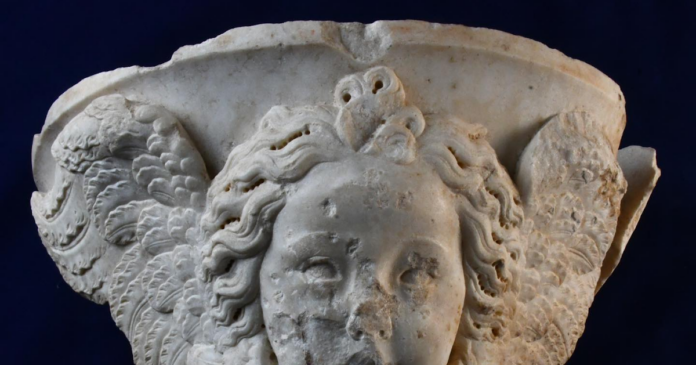 |
| Marble console from the Franciscan Church of Visegrád |
Archaeological excavations carried out in 2024 have brought to light the remains of the former Franciscan church at Visegrád. In 1425, the site of the former chapel of Saint George was given to the Observant Franciscans by King Sigismund – the newly established monastery was located right next to the royal palace in the lower town of Visegrád. The site of the monastery buildings had already been excavated during the 1980s-1990s. It was well-known from those excavations, that the original monastery was rebuilt in the late Gothic period, starting with a formal reestablishment of the institution by King Matthias in 1473. There was no chance until now to excavate the site of the church itself, which is located just south of the monastery quadrant. The church’s location was known precisely, as the southwestern corner of the sanctuary had already been found at the earlier excavations. As the monastery of the Observant Franciscans was founded by the king and was part of the palace complex, there was no doubt that the church had to be a building worthy of a royal residence.
Consoles with cherub heads, encircled by wings appear on several works of Benedetto da Maiano, such as the eucharistic ciborium at the Collegiata of San Gimignano or on his smaller tabernacle at Santa Barnaba in Firenze, and on the Strozzi tomb in Santa Maria Novella. At Visegrád, two such consoles were found, so a more elaborate structure, perhaps an altarpiece was made by Benedetto in the 1480s. Fragments of an adoring angel – possibly similar to those seen on the Strozzi tomb – were also found, indicating a larger sculptural ensemble.
 |
| Carvings attributed to Benedetto da Maiano from the Franciscan Church of Visegrád |
It is not at all certain that Benedetto da Maiano’s altar was erected in the church during King Matthias’s lifetime, as the choir and sanctuary vaults were only completed during the reign of the next ruler, Wladislas II. The building received an elaborate Late Gothic net vault, which could be reconstructed from the large number of rib fragments found. Late Gothic was quite popular at the time of King Matthias and his Jagiellonian successors – in churches, usually only some elements of internal furnishings, namely tabernacles, and altarpieces were made in Renaissance style. This was the case for example at the Inner City parish church of Pest (now Budapest), where a Renaissance white marble altar and two red marble tabernacles were installed in the early 16th century. The Franciscan church at Visegrád was built as a Gothic church and thus had to be finished with a Gothic vault. The theoretical reconstruction of the vault was carried out by Balázs Szőke.
 |
| Theoretical reconstruction of the vault of the Franciscan Church of Visegrád, created by Balázs Szőke |
The supposition is that the design and construction of the Franciscan Church of Visegrád took place in the 1490s, before Master Anton returned to his native Brno in 1500. We are not sure when construction was finished, but in 1513, the general assembly of the Observant Franciscans was already held at the church. By this time the Renaissance white marble carvings of Benedetto da Maiano must have been installed under the late Gothic vaults designed by Anton Pilgram. This duality of styles – and the desire to seek out the best artists of their generation – characterized the last decades of medieval Hungary, just before the catastrophic battle of Mohács in 1526. Although 1526 did not mean the end of the Franciscan monastery at Visegrád, the church was ravaged by the Ottoman troops at that time. Visegrád was later sieged by King Ferdinand in 1540, after the death of his opponent, King John of Szapolyai. This internal conflict was eventually resolved by Suleiman the Magnificent and his Ottoman troops, who occupied Buda in 1541. The Kingdom of Hungary was divided into three parts, and the Turks eventually occupied Visegrád in 1544. After this, the Franciscan church and monastery fell into ruin along with the adjacent royal palace, and their stones were later used for construction in the village. Almost nothing remained on the site until the period of 20th-century archaeological excavations. The history of medieval art in Hungary has to be reconstructed from the fragments this research has brought to life.
The excavations have already generated a lot of publicity. You can follow the developments in the Archheologia Altum Castrum online magazine of the King Matthias Museum, or have a look at this detailed article by András Zsuppán on Válasz Online (in Hungarian). You can also look at these two videos for a better idea of the importance of the finds.
All photos courtesy of the HNM King Matthias Museum, Visegrád




